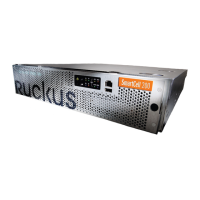• Management Rx (Port2, Port5)
2. To stop the Cluster Real-time Monitor, click the Stop Monitoring button on the upper-left
part of the page.
Monitoring Rogue Access Points
Rogue (or unauthorized) APs pose problems for a wireless network in terms of airtime contention,
as well as security.
Usually, a rogue AP appears in the following way: an employee obtains another manufacturer's
AP and connects it to the LAN, to gain wireless access to other LAN resources. This would
potentially allow even more unauthorized users to access your corporate LAN - posing a security
risk. Rogue APs also interfere with nearby Ruckus Wireless APs, thus degrading overall wireless
network coverage and performance.
The controller's rogue AP detection options include identifying the presence of a rogue AP,
categorizing it as either a known neighbor AP or as a malicious rogue.
If you enabled rogue AP detection when you created an AP zone, click Monitor > Rogue Access
Points. The Rogue Access Points page displays all rogue APs that the controller has detected
on the network, including the following information:
• Rogue MAC: MAC address of the rogue AP.
• Type: Type of rogue AP detected. Possible values include:
• Rogue: A normal rogue AP. This rogue AP has not yet been categorized as malicious or
non-malicious.
• Malicious AP (SSID-spoof): A malicious rogue AP that uses the same SSID as a
controller-managed AP (also known as an Evil-twin AP).
• Malicious AP (MAC-spoof): A malicious rogue AP that has the same BSSID (MAC) as
one of the virtual APs managed by the controller.
• Malicious AP (Same-Network): A malicious rogue AP that is connected to the same
wired network.
• Channel: Radio channel used by the rogue AP.
• Radio: WLAN standards with which the rogue AP complies.
• SSID: WLAN name that the rogue AP is broadcasting.
• Encryption: Indicates whether the wireless signal is encrypted or not.
• Last Detected: Date and time when the rogue AP was last detected by the controller.
SmartCell Gateway 200/Virtual SmartZone High-Scale for Release 3.4.1 Administrator Guide
303
Monitoring the System, Alarms, Events, and Administrator Activity
Monitoring Rogue Access Points

